5-Ingredient Einkorn Sourdough Bread
This post may contain affiliate links. Please read my disclosure policy.
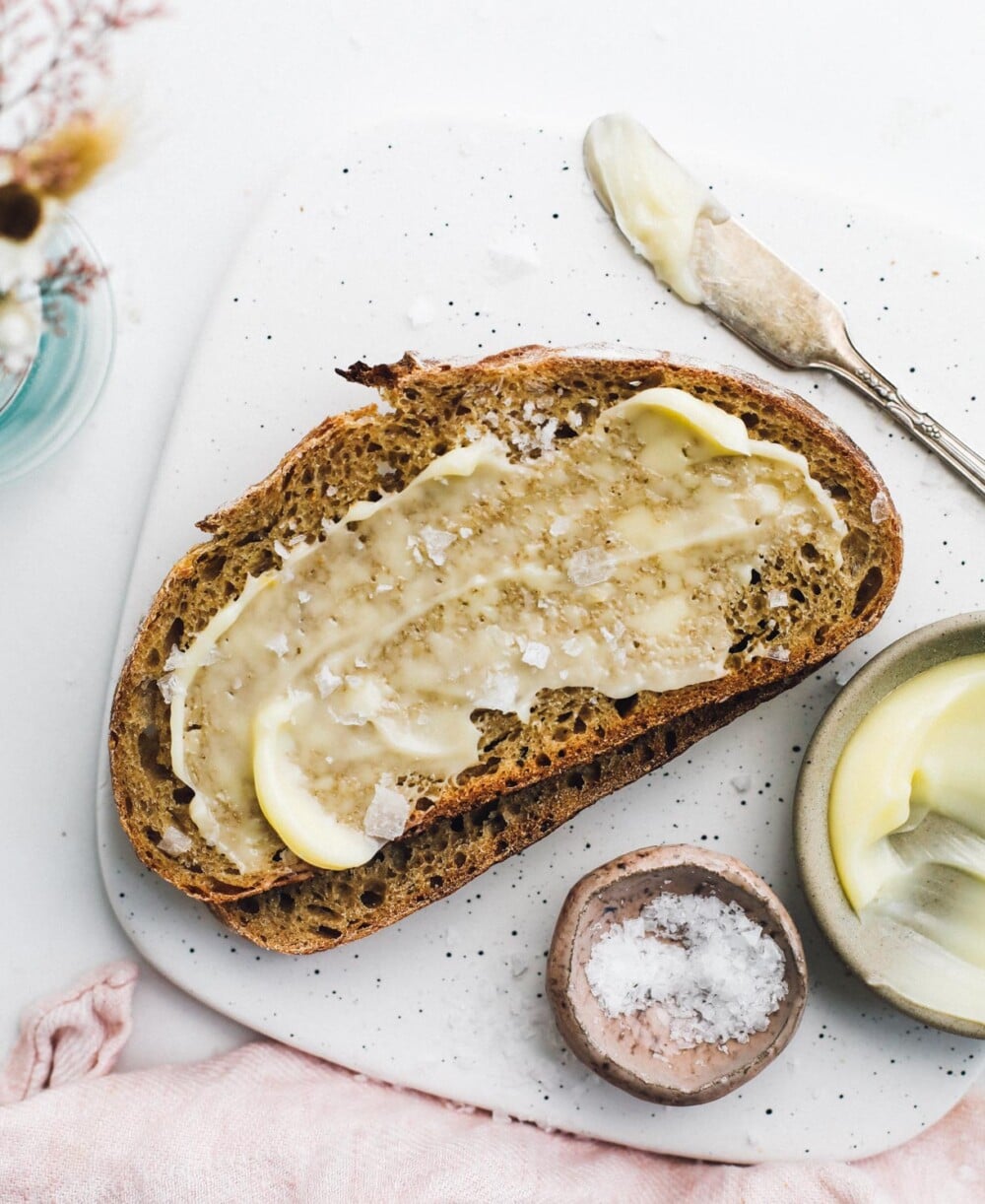
This post is sponsored by Flourist, a Canadian mill and bakery that sources the highest quality grains from family farms and mills them to order. Their flours have made a profound impact on my sourdough baking in both flavor and texture, and I’m excited to share them with you.
Why I Love Einkorn Sourdough Bread:
The rich, tangy, and warm flavor of this nutrient dense einkorn sourdough is incredible, unlike any other bread I’ve made. There’s balance in the structure; with a tender interior and substantial, crackly exterior. This loaf stays perfectly moist for several days on the counter, too!
And it makes the perfect slices for toast and sandwiches.
To keep this homemade sourdough bread soft on the inside and workable while making, the hydration is moderate. It will be a bit stickier than a loaf made with all bread flour or even Whole Wheat Sourdough Bread, but just trust it.
You’ll need to build strength in the initial stages of bulk fermentation, incorporating an aggressive initial mix and then stretch and folds, similar to my Spelt Sourdough Bread recipe. This will help the dough keep its shape later on.

What is einkorn?
Einkorn is a nutritious ancient wheat grain. It was one of the very first plants to be domesticated and cultivated, but is the only wheat to have never been hybridized. Einkorn is higher in protein and lower in carbohydrates than modern wheat, and also known to be easier to digest because of its weak gluten.
When milled, it results in a pillowy soft flour that is lovely in cakes, cookies, and bread. The deep, nutty flavor of einkorn is phenomenal, and you’ll notice it right away in this loaf, along with it’s golden color.
I get my einkorn flour from Flourist, and it’s absolutely the freshest, most beautifully milled flour I’ve worked with. They work with Canadian family farms to source premium local grains and beans, then stone mill the grain in-house, to order. The flour has the softest feel and adds more flavor to my sourdough than any other brand of flour I’ve used.
How is baking sourdough with einkorn flour different?
- Because of its low gluten content, the dough will feel stickier and more slack compared to working with all purpose and bread flours, known as high gluten flours. Don’t be alarmed – the dough will become less sticky and tighter by the end of your stretch and folds.
- A one hour long autolyse (initial rest) is incorporated to allow the whole grains to absorb the water.
- Rather than the bulk fermentation being finished when the dough has doubled, the bulk fermentation of this einkorn sourdough is done when the top is smooth, it has increased about 70% in size, and jiggles slightly when you move the bowl.
- The low gluten content of einkorn means that you will not get as lofty and airy of a rise like you would with basic sourdough. However, you will get triple the flavor! A great compromise.
Knowing this before making this recipe is important.
For these reasons, I like to use einkorn flour in combination with bread flour, for a balance of high/low gluten percentages. This allows for excellent structure in the loaf, while the einkorn contributes a complex flavor and wonderful softness.
How to Make Einkorn Sourdough and Baker’s Schedule:
The steps to make this einkorn sourdough are based on my rye sourdough recipe, and are very straightforward.
- Around 2pm: Mix dough: Add starter and water to a bowl. Whisk thoroughly until combined, with a fork. Add flours, and mix together first with the fork to start to incorporate, then with your hands until a shaggy dough is formed, and the bits of flour disappear. Sprinkle the salt on top and do not mix in, just leave it on top. Cover with a damp cloth.
- Autolyse: let dough sit for one hour, covered and undisturbed.
- Around 3pm: Bulk ferment: Now you will knead the salt that is sitting on top, aggressively working the dough for about 3 minutes. There is no precise way to do this, just think of working the dough through your hands and up against the bowl, push and pull. You will start to feel the dough relax a bit around 2 minutes. Then leave the dough alone, covered, for 30 minutes. This counts as what would be your first set of stretch and folds.
- After those 30 minutes pass, perform a set of stretch and folds. Repeat the 30 minute rest + stretch and fold, 2 more times.
- 4:30pm – Now you will let the dough sit, undisturbed and covered with a damp cloth to finish its bulk fermentation. The temperature in my home is 72 degrees F. My dough was finished with the bulk ferment at 8pm. If the temperature in your home is above 72, the dough will take less time to rise, vice versa. You will know it is finished with its bulk ferment when the dough is slightly short of doubled, is smooth and puffy on top, with a few bubbles. It will not be as jiggly as some sourdough you’ve made before.
- Around 8pm: Then shape your dough, using this method as a guide.
- Around 8:30pm: Place dough into your rice flour dusted banneton for its final rise, either overnight or on the counter. Use this video as a guide to know when the final proofing is done.
- Around 7:30am: Time to bake. Preheat your oven to 475 degrees F, with your dutch oven preheating inside the oven. When the oven is preheated, flip your dough out gently onto parchment paper and score your dough. If you did the final rise in the refrigerator, take it straight from fridge to scoring. You should score it cold, and DO NOT need to let it come to room temp. Use this guide to learn how to score sourdough bread.
- Then place in your pre-heated dutch oven and bake!
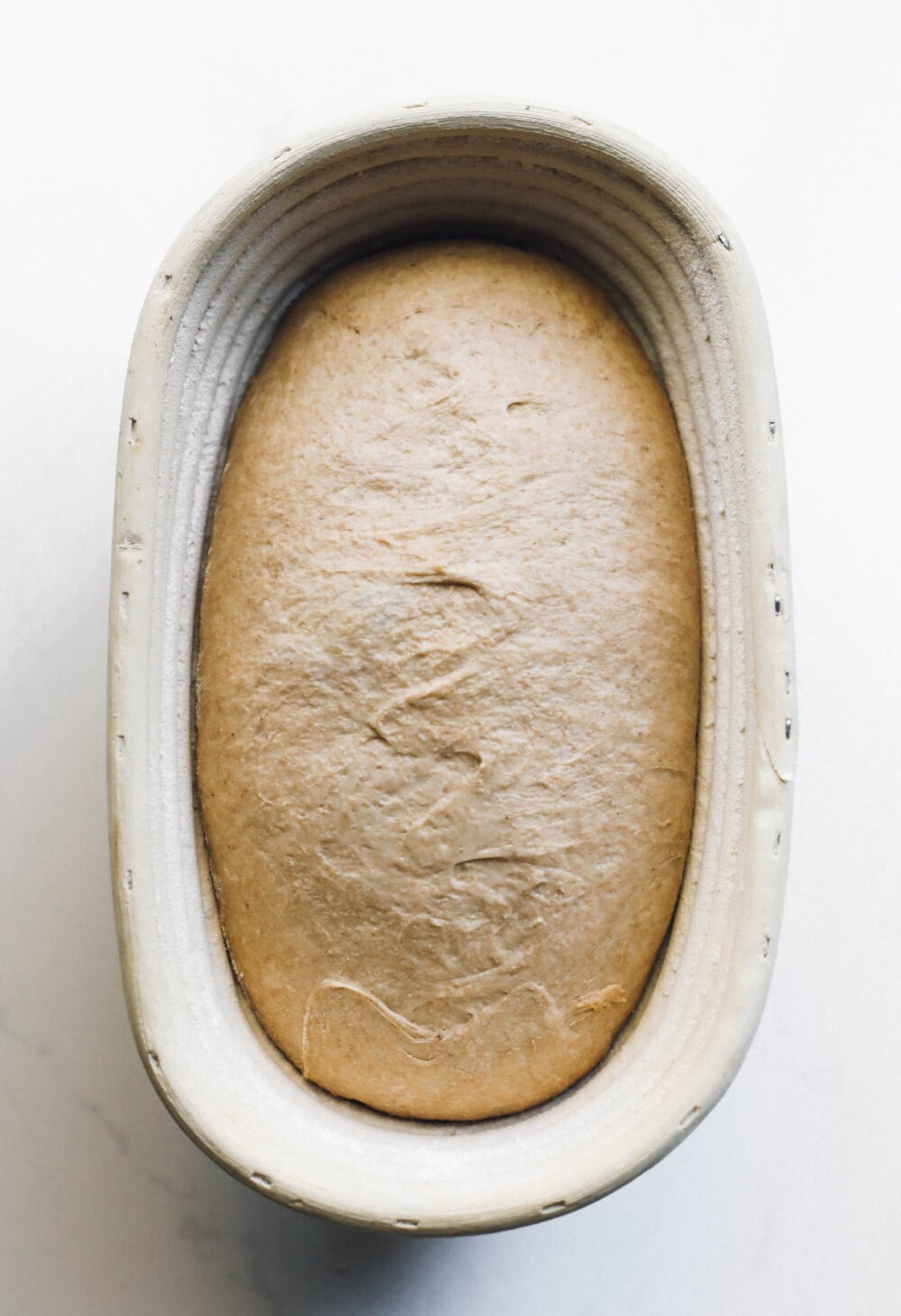
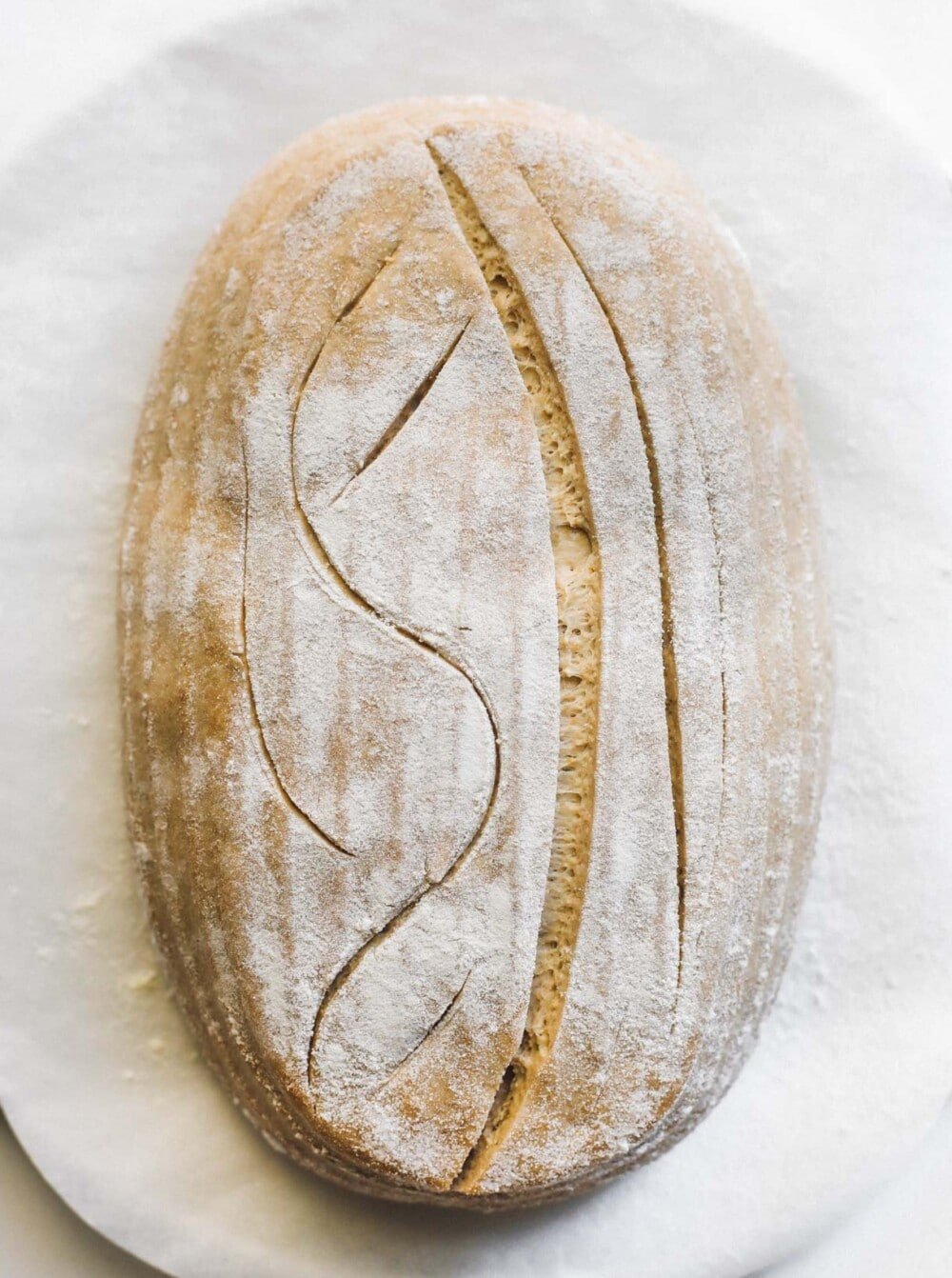
Do I have to have an einkorn starter to make this bread?
Nope! To make things easy, I developed this recipe using my all-purpose sourdough starter, which is the most common type of sourdough starter that people have. It works beautifully. Of course if you have an einkorn sourdough starter, it will work great too.
How do I know when my dough is correctly proofed and can be baked?
You can use this simple test for your final rise to know if your dough is correctly proofed. Gently press a floured thumb into your risen dough. You don’t need to press down further than 3/4 inch.
If your fingerprint jumps right back up to flat, it needs more time to rise and would be underproofed if you baked it. If your fingerprint indents and doesn’t bounce back at, it is overproofed. That’s okay, just get it in the oven! It will still taste delicious, it will just not rise as well while baking. If your fingerprint indents and gradually releases, but still holds a finger shape, you’re ready.
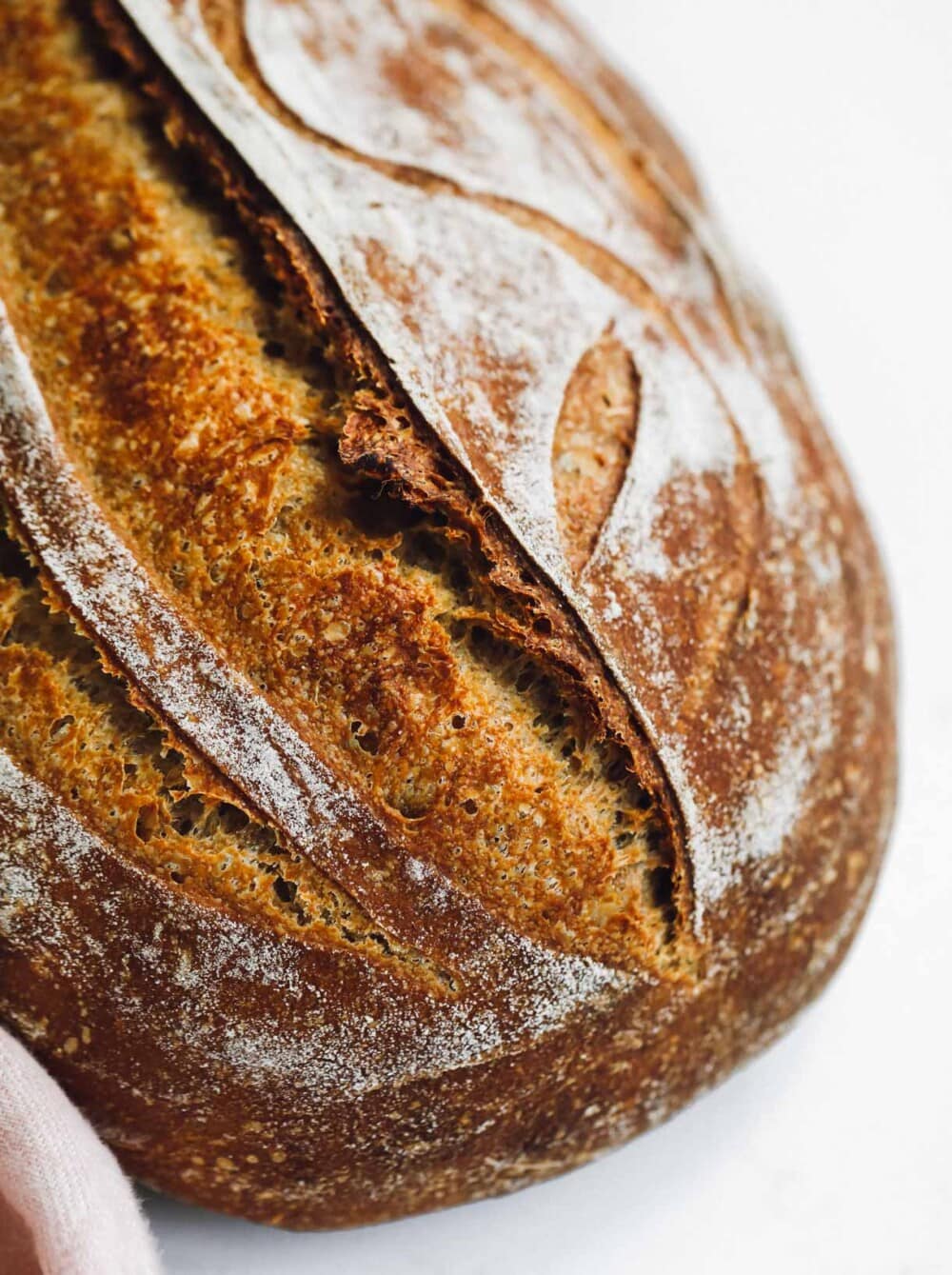
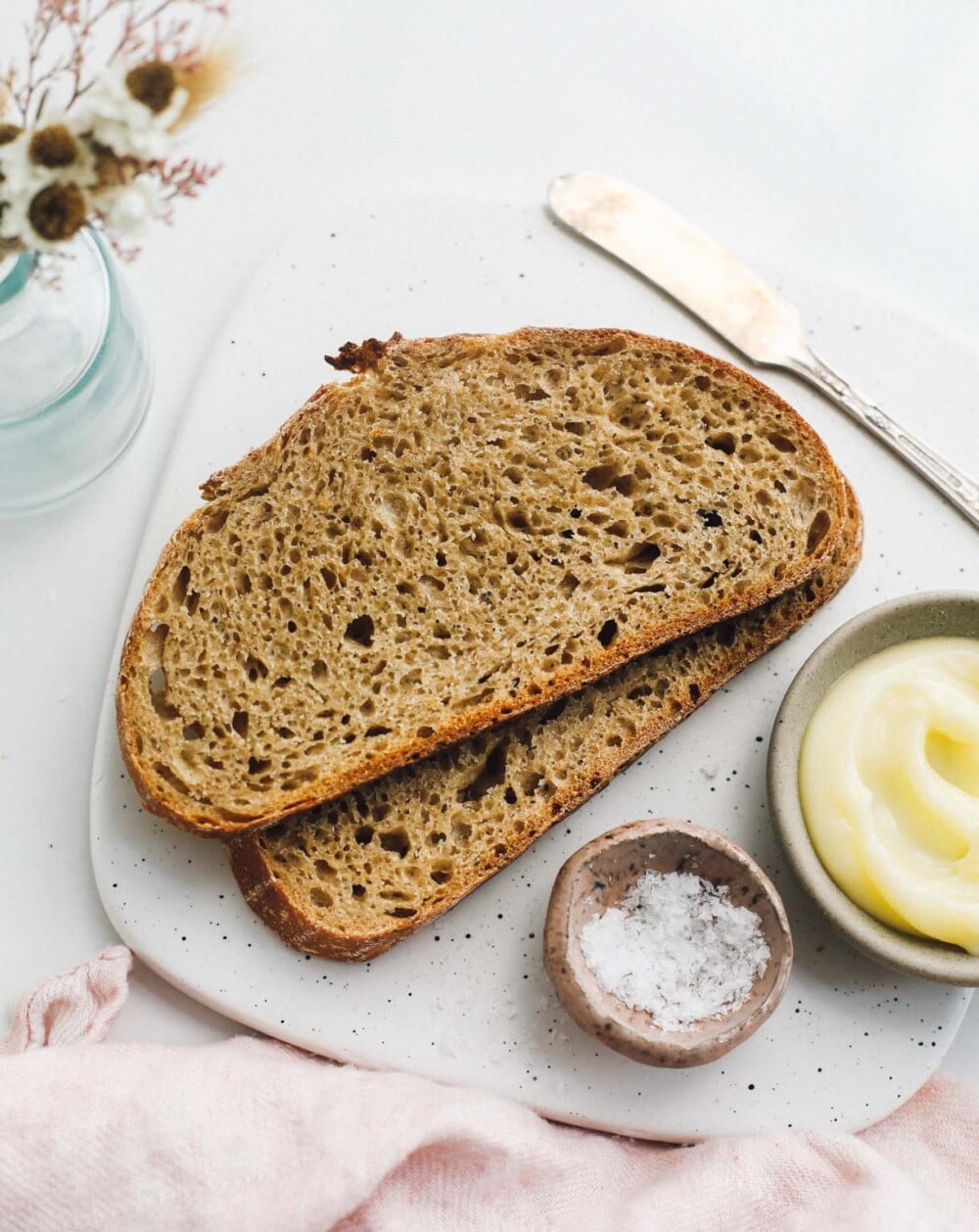
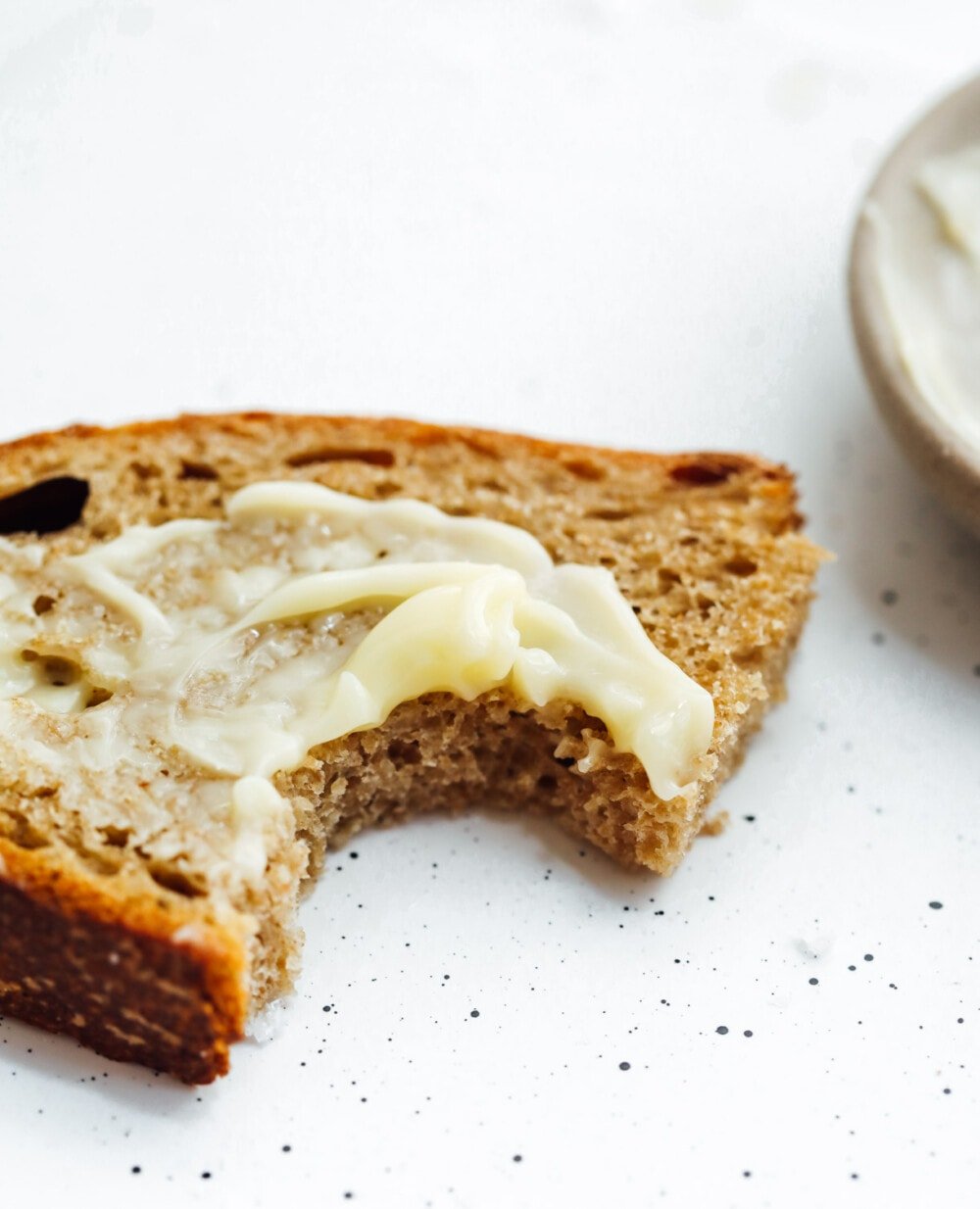
More Sourdough Recipes:
- Honey Sourdough Bread with Roasted Walnuts
- Homemade Whole Wheat Sourdough Bread
- Sun-Dried Tomato & Cheddar Sourdough Bread

5-Ingredient Einkorn Sourdough Bread
SCALE:
Ingredients
- 60 grams active sourdough starter, at its peak
- 290 grams slightly warmer than room temp water
- 190 grams Flourist whole grain einkorn flour
- 230 grams Flourist sifted spring wheat or bread flour
- 9 grams fine salt
Equipment
Instructions
- Before beginning, it will be helpful to note that the dough will be stickier than normal because of the einkorn flour, but it will come together – you just have to trust!
- Add starter and water to a bowl. Whisk thoroughly until combined, with a fork. Add flours, and mix together first with the fork to start to incorporate, then with your hands until a shaggy dough is formed, and the bits of flour left just disappear. Sprinkle the salt on top and do not mix in, just leave it on top. Cover with a damp cloth.
- Autolyse: let dough sit for one hour, covered and undisturbed.
- Bulk ferment: Now you will knead the salt that is sitting on top, aggressively working the dough for about 3 minutes. There is no precise way to do this, just think of working the dough through your hands and up against the bowl, push and pull. You will start to feel the dough relax a bit around 2 minutes. Then leave the dough alone, covered, for 30 minutes. This counts as what would be your first set of stretch and folds.
- After those 30 minutes pass, perform a set of stretch and folds. Repeat the 30 minute rest + stretch and fold, 2 more times.
- Now you will let the dough sit, undisturbed and covered with a damp cloth to finish its bulk fermentation. The temperature in my home is 72 degrees F. My dough was finished with the bulk ferment in 5 hours, starting with my first set of stretch and folds at 3pm, and it finished bulking at 8pm. If the temperature in your home is above 72, the dough will take less time to rise, vice versa. You will know it is finished with its bulk ferment when the dough is slightly short of doubled, is smooth and puffy on top, with a few bubbles. It will not be as jiggly as some sourdough you’ve made before.
- At this point, lightly dust your work surface with flour. Put dough onto the work surface, and pre-shape. Then let sit for 15 minutes on your work surface.
- Then shape your dough, using this method as a guide.
- Place dough into your rice flour dusted banneton seam side up. (Optional, you can wait 15 minutes after placing it in banneton, and pinch the perimeters of the dough into the center to hold the shape even more, called stitching.)
- The dough will now go through its final rise. You can do the final rise overnight in the refrigerator, with the banneton placed inside a plastic shopping bag or covered with a shower cap. You need this for holding moisture in. Or you can do the final on the counter, which will take about 1 1/2 hours at 70 degrees F for the dough to puff up and be jiggly. It will not double. Use this video as a guide to know when the proofing is done.
- Time to bake. Preheat your oven to 450 degrees F, with your dutch oven preheating inside the oven. When the oven is preheated, flip your dough out gently onto parchment paper and score your dough. If you did the final rise in the refrigerator, take it straight from fridge to scoring. You should score it cold, and DO NOT need to let it come to room temp.
- Then put dough into the dutch oven on the parchment, and put cover on. Slide dutch oven in. Bake for 20 minutes, then remove cover.
- Turn heat down to 430 degrees F, and bake for 25 more minutes, until crust is golden brown and crackly. Remove from oven, and remove bread from dutch oven and place onto a cooling rack. (**Einkorn bread does not have as high of a rise as sourdough made with other flours. Don't be disappointed, this is just the nature of it and the flavor is incredbile, and what this bread is all about!)
Notes
Did you make this?
tag @heartbeetkitchen on instagram and hashtag it #heartbeetkitchen

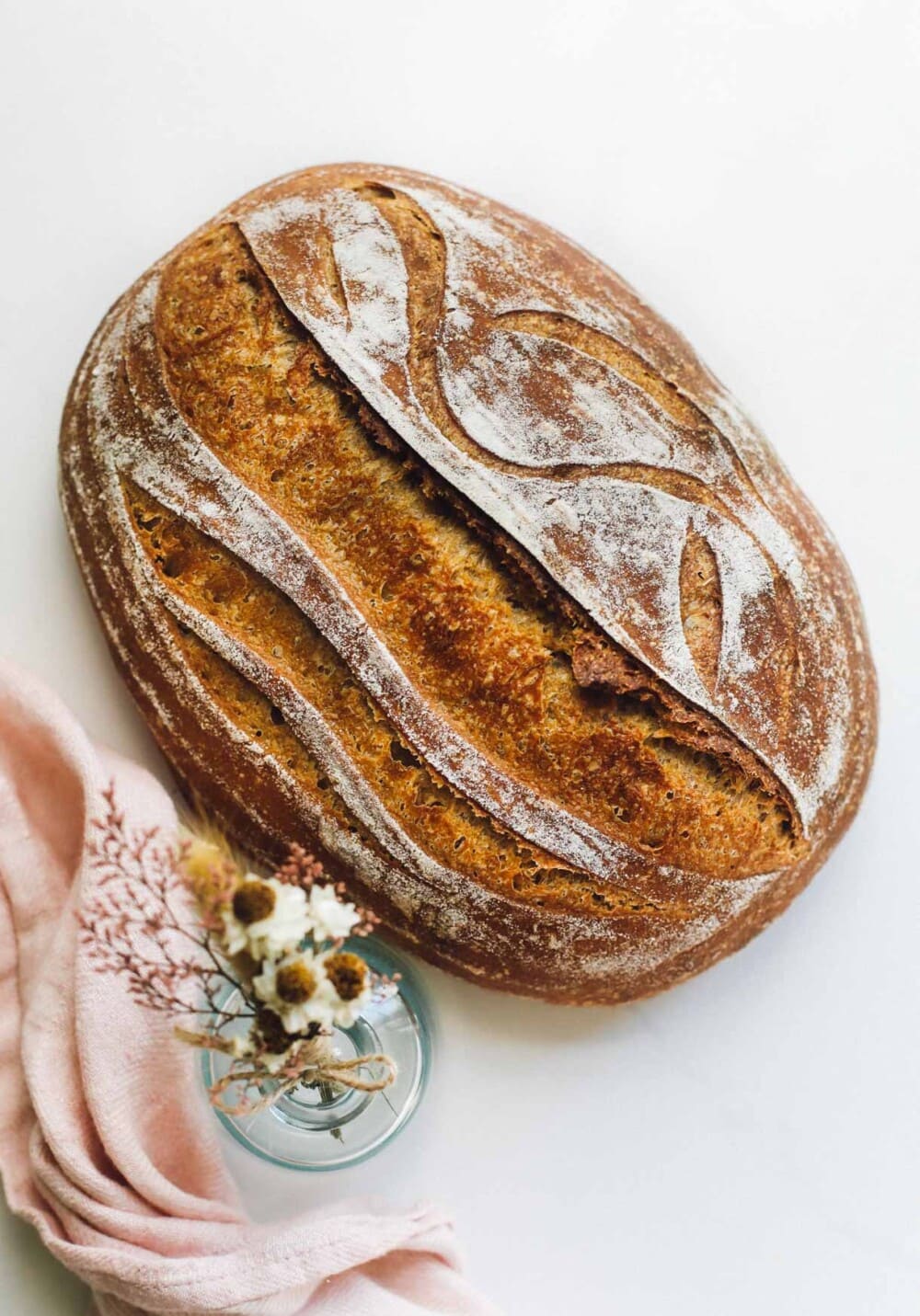

Madalina Madalin
April 13, 2024
Made this recipe several times. Delicious each time. Recently, I’ve started using fresh milled einkorn and the flavor is divine.
Thank you for the recipe, I had a hard time finding a good einkorn sourdough recipe, and this one never fails.
corky
March 24, 2024
Thank for the very helpful time schedule. I’m new to sourdough. I want to make a sourdough loaf using all einkorn flour. Can I replace the bread flour and use all einkorn flour in this recipe and get good results. Thank you.
Amanda Paa
March 24, 2024
Hello! You will want to use the bread flour, as this provides structure and rise to the loaf. An all einkorn sourdough is very dense. This recipe has not been developed for that.
Madison Warren
March 19, 2024
Hello! Would I be able to add rye flower in addition to the einkorn and bread flour? If so how many grams? Thank you!
Amanda Paa
March 19, 2024
Hello! I haven’t tested this with rye flour, but I do have a rye sourdough bread recipe if that interests you!
Janet Cook
February 17, 2024
I have all purpose einkorn flour, and would like to use more all purpose wheat flour to get more crumb. My starter is with wheat all purpose. Can you suggest an adjustment like 70% all purpose wheat and 40% einkorn all purpose?
Amanda Paa
February 18, 2024
Hi Janet! I would need to test it to give you an adjustment. Sorry!
Sandra Slater
January 17, 2024
Hello! Getting ready to try this recipe, however, do not have bread flour. It’s snowing so no trip to the market today. Is it okay to substitute all-purpose flour for the bread flour? If so, would the gram amount be the same? Thank you for your response.
Amanda Paa
January 19, 2024
Hello! Bread flour and all purpose are not interchangeable for sourdough, unfortunately. Bread flour soaks up a lot more water and has more strength; if you use all purpose it will be very wet and weak.
Julie
October 9, 2023
Hi Amanda, What a beautiful website – lovely pictures and descriptions! Makes me want to stop everything and get to baking bread. I do have experience with baking bread, but not too much with sourdough. I think I will purchase your starter however and step into it. Amanda, my hubby is gluten intolerant (not celiac) and I read, not too long ago, where you tired your sourdough bread carefully, noting any reactions, etc. and delightly found none! Woo hoo! Hubby said he would try it as he misses bread. Ive tried multiple times Gluten Free Bread recipes and have to say, it is its own “animal” :) Could you help me out by letting me know which recipe I should try for him? Much, much appreciated Amanda!
Sabrina
April 5, 2023
I am a new baker and wanted to try einkorn, as I heard it has a lower gluten content, but wanted an easy recipe to learn how to get comfortable with the dough. This recipe is simple, delicious, and I get consistent results every time! I have made 5 or 6 loaves and it has been a hit with friends, and I freeze and toast the leftovers so I can keep enjoying it for days :). Thanks for the great recipe!
Amanda Paa
April 5, 2023
Wonderful to hear, Sabrina! Glad to hear about your success with the einkorn sourdough.
Jennifer
January 3, 2023
Great recipe to try Einkorn flour! Although it was a bit stickier than my usual sourdough bread, it was still workable. I used bread flour for the balance of flour and did the overnight cold retard. My whole family loved the flavor. I was impressed with the oven spring. Will definitely make again.
Amanda Paa
January 3, 2023
Glad you enjoyed it, Jennifer! Yes, einkorn is definitely stickier to work with, and you can dip fingertips in water to help that next time if needed.
Emily
November 21, 2022
I finally made this recipe with fresh ground einkorn and it is delicious! Thanks for such a well written recipe, it may be my new favorite loaf!
Amanda Paa
November 21, 2022
Yay! Isn’t the flavor of einkorn amazing? I’m so glad you liked the recipe.
J'sLulu
October 17, 2022
I really enjoyed the flavor of this bread. I actually allowed it to sit in the fridge for the fermentation process over night because I had misread prior to starting and didn’t time things right, but it worked out just fine. Thanks for incorporating Einkorn into many recipes I love this particular flour and LOVE all things sourdough due to following FODMAP as much a possible.
Amanda Paa
October 18, 2022
Great to hear! I’m so glad you enjoyed this einkorn sourdough. I love the flour too.
Xander
June 29, 2022
Although delicious, please, no more sourdough recipes! you are such an incredible cook & baker…Please get in that gorgeous kitchen of yours and send some seasonal masterpieces our way instead! Can’t wait!!